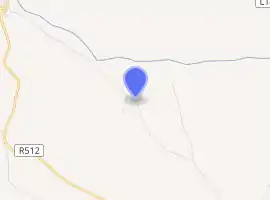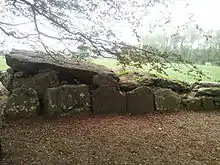Labbacallee wedge tomb
Labbacallee wedge tomb (Irish: Leaba Chaillí "Hag's Bed") is a large pre-historic burial monument, located 8 km (5.0 mi) north-west of Fermoy and 2 km (1.2 mi) south-east of Glanworth, County Cork, Ireland. It is the largest Irish wedge tomb and dates from roughly 2300 BC.[1]


Features
The site has three large capstones which slope downwards towards the back, the largest being 7.8 m (26 ft) long and weighing 10 tonnes (9.8 long tons; 11 short tons). The gallery below is made up of a large rectangular chamber, with a small one behind it, divided by a slab. The gallery is triple-walled, buttressed at the back by three slabs set parallel to the axis of the tomb. To the front of the gallery are the remains of a large rectangular unroofed antechamber which is wider than the gallery and separated from it by a large slab.[1] Outside this there was a further row of stones running off at an angle, but few of the original stones remain.
Excavations
In 1934 excavations revealed a number of inhumations, fragments of a late Stone Age decorated pot, and fragments of bone and stone. Local folklore associates the site with the Celtic Hag-Goddess Cailleach Bheur, and during the excavations the site was found to contain the remains of a woman. Although the body had been positioned within one chamber of the tomb, her skull was found in another chamber.
References
- Weir, A (1980). Early Ireland. A Field Guide. Belfast: Blackstaff Press. p. 118.
Sources
- "Labbacallee". The Megalithic Portal. Retrieved 2008-06-14.
- Noonan, Damien (2001). "Castles & Ancient Monuments of Ireland", Arum Press. ISBN 1-85410-752-6
External links
- Megalithic Ireland - Photographs of Labbacallee wedge tomb
- Megalithomania - Site plan and photographs of Labbacallee Wedge Tomb
- Ancient Ireland - Photographs of Labbacallee - Leaba Callighe - Hag's Bed
| Wikimedia Commons has media related to Labbacallee wedge tomb. |